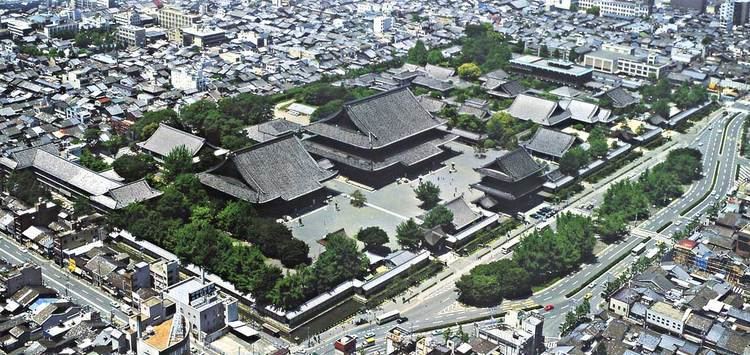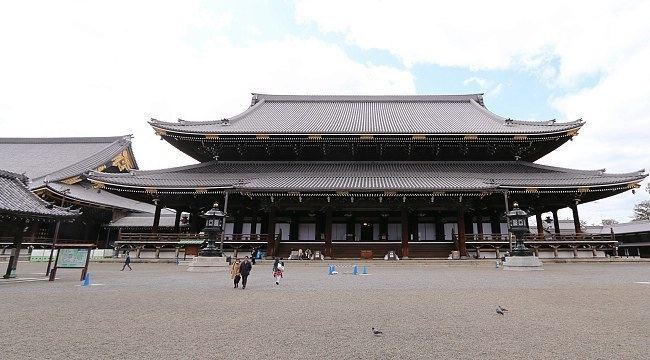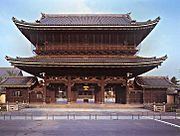Opened 1591 | Founder Kōsa | |
 | ||
Similar Nishi Honganji, Tō‑ji, Nijō Castle, Kiyomizu‑dera, Kinkaku‑ji | ||
tsukiji hongan ji temple
Hongan-ji (本願寺, Temple of the Primal Vow), also archaically romanized as Hongwanji, is the collective name of the largest school of Jōdo Shinshū Buddhism (which further sub-divides into the Nishi and Higashi branches). 'Hongan-ji' may also refer to any one of several actual temple buildings associated with the sect.
Contents

Early history

The Hongan-ji was established as a temple in 1321, on the site of the Otani Mausoleum, where Shinran, the founder of the Jōdo Shinshū ("True Pure Land") was buried. The mausoleum was attended by Shinran's grandson (through daughter Kakushinni), Kakue. Kakue's own son, Kakunyo, became the first chief priest of the Hongan-ji and third monshu (spiritual leader), and dedicated it to the worship of Amitābha (Amida). The Hongan-ji first gained power and importance in the 15th century, when Rennyo became its eighth monshu. However, the Tendai based on Mount Hiei saw this expansion as a threat and attacked the Hongan-ji three times with their army of sōhei. Rennyo fled to Yoshizaki-gobō, where he established a new temple compound.

During the Sengoku period, fearing the power of the monks of the Hongan-ji, Oda Nobunaga tried to destroy it. For ten years, he laid siege to the Ishiyama Hongan-ji in Osaka, one of the two primary temple fortresses of the sect.

In 1602, just after Tokugawa Ieyasu became shogun, he declared that Hongan-ji be split in two. Kyonyo, the twelfth monshu of Hongan-ji, became the first head of the new Higashi Honganji (東本願寺 "Eastern Honganji"), while his younger brother Junnyo became the twelfth chief priest of the Nishi Honganji (西本願寺, "Western Honganji"; sometimes called the Hompa Honganji 本派本願寺).
Nishi Hongan-ji

Formally known as the Jodo-Shinshu Honganji-ha is the largest of all the Jodo Shinshu branches. Compared to the Higashi Honganji it has a history of institutional stability that accounts for high membership figures, and a larger geographical reach, but fewer well-known modern thinkers. The Nishi Hongan-ji has a sizable number of overseas temples in the U.S.A., South America, Hawai'i, Canada, and Europe which are organized into several kyodan ("districts"). The largest of these is the Buddhist Churches of America.

The Hongwanji International Center, to the east of Nishi Hongan-ji, coordinates dialogue with Jōdo Shinshū organizations around the world and produces translation work.
The Nishi Hongan-ji operates the Hongwanji Publishing Company which produces books, music, films, and anime about Jōdo Shinshū Buddhism. They also publish a bimonthly newspaper, the Hongwanji Journal and their website includes, among other things, a TV channel devoted to explaining Buddhism and Hongan-ji's everyday operations.
Higashi Hongan-ji
Higashi Honganji is one of the two dominant subsects of Jōdo Shinshū, the other being the Nishi Honganji.
During the Meiji Restoration in the 1860s, the government set down new guidelines for the management of religious organizations. An organization called Ōtani-ha was put in control of Higashi Honganji. In 1987, this temple was renamed Shinshū Honbyō "Shinshū Mausoleum", although the earlier name is still used. The buildings have not been changed or moved, and of course the historical cultural and religious significance of the place has not changed.
Due to opposition to the creation of the Ōtani-ha, and a number of other controversies and disputes such as the Ohigashi schism, several new Higashi Hongan-ji branches came into existence such as the Higashiyama Honganji, founded in Kyoto in 1996 by Otani Korin, and the Tokyo Higashi Honganji, whose current leader is Otani Koken. Despite, or perhaps even because of, this climate of instability, the Higashi Honganji movement has also produced a significant number of controversial but influential thinkers, such as Soga Ryōjin, Kiyozawa Manshi, Kaneko Daiei and Akegarasu Haya, amongst others.
The largest Higashi Hongan-ji grouping, the Ōtani-ha has approximately 5.5 million members, according to statistics.
Joint activities
In recent years some members of the Honganji sects have been involved in high-profile protests against the visits of Japanese politicians to the controversial Yasukuni Shrine.
Along with the other non-Honganji Jōdo Shinshū subsects, the Honganji issued a statement opposing the 2003 invasion of Iraq.
Higashi Hongan-ji
The Shinshū Honbyō, the mausoleum of Shinran, is now owned by the Ōtani-ha but is still commonly called Higashi Honganji (東本願寺) by Kyoto visitors and locals. The massive Goei-dō (also known as Mie-dō), or Founder's Hall Gate, is often one of the first things one sees walking north from JR Kyōto Station. Nearly identical to the Nishi Hongan-ji head temple in layout, it too features an Amida-dō, and a larger Mie-dō. The Mie-dō at Higashi Hongan-ji dates from 1895 and vies with a number of other structures for the claim of largest wooden building in the world.
A few blocks from the main grounds of the Higashi Hongan-ji is the Shosei-en garden, owned by the temple. Poet-scholar Ishikawa Jozan and landscape architect Kobori Masakazu are said to have contributed to its design in the 17th century.
Nishi Hongan-ji
The Nishi Honganji, like the Higashi Honganji, features a huge Goeidō (御影堂), Kaisando and a smaller Amida-dō (阿弥陀堂) or Amitābha hall housing an image of Amitābha. Nishi Hongan-ji's Kura (倉), or storehouse, houses many National Treasures, most of which are not on view for the public. The shoin (書院), or study hall, is also quite famous; it is split into two sections, the shiro-shoin(白書院), or white study hall, and the kuro-shoin(黒書院), or black study hall.
Nishi Hongan-ji also contains a large shogun complex from the medieval period, which was largely moved into the temple from elsewhere in Kyoto in the 16th century. This includes Hiunkaku (飛雲閣), a large tea pavilion, four Noh stages, one of which is thought to be the oldest in existence and the other being the largest outdoor Noh stage, and the Kokei no Niwa (虎渓の庭) garden.
Some medieval parts of Nishi Hongan-ji are now independent organizations: Ryukoku University and Kōshō-ji.
